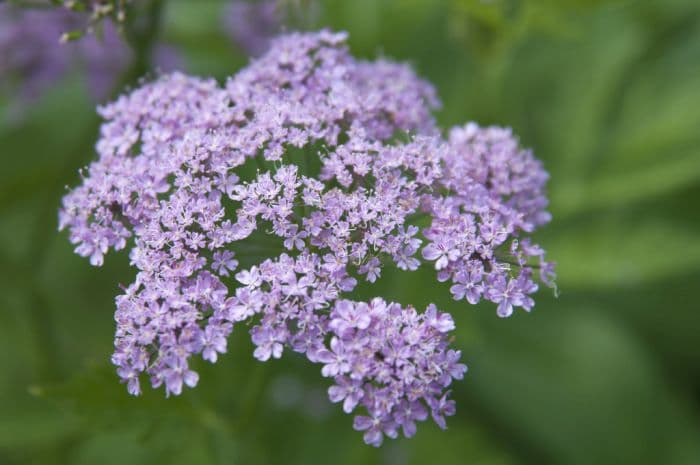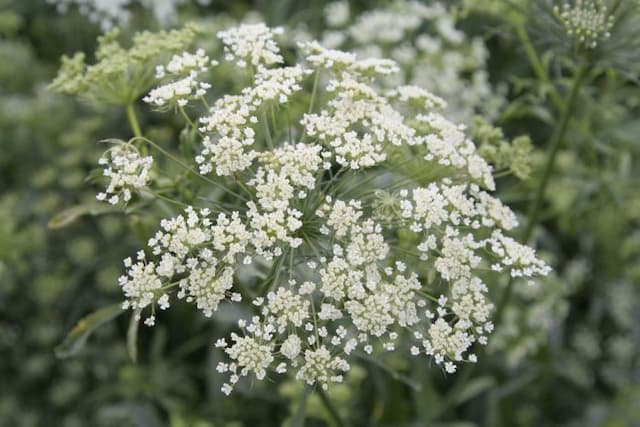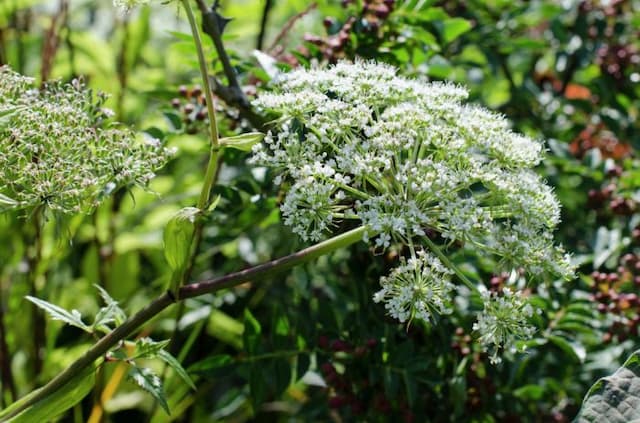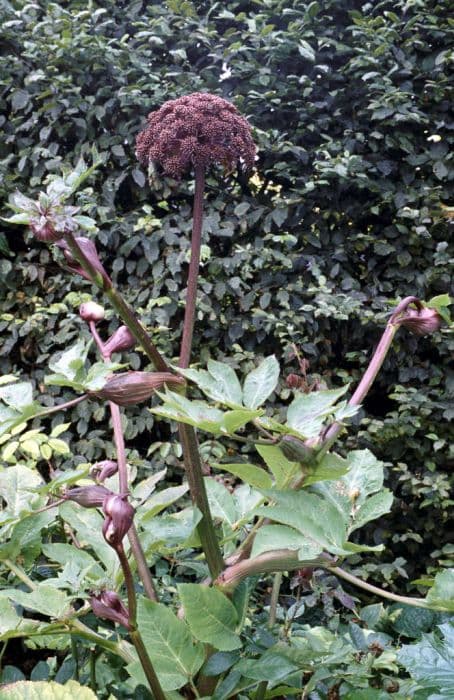Greater Burnet Saxifrage Pimpinella major 'Rosea'

ABOUT
Pimpinella major 'Rosea', more commonly known as Greater Burnet Saxifrage, is a perennial herb that adds a graceful touch to garden spaces with its delicate and airy appearance. It features a clump-forming habit with a rosette of leaves at its base. The leaves are pinnate, meaning they have multiple leaflets arranged on either side of a common axis, giving them a feather-like appearance. Each leaflet is broad, oval to circular in shape, and can be either smooth or slightly serrated along the edges. During blooming season, the plant produces tall, slender stalks topped with compound umbels of small, attractive flowers. These flowers are a soft, pastel pink hue that appear frothy and ethereal, making them a favorite among pollinators such as bees and butterflies. The inflorescence has a somewhat umbrella-like shape, with multiple tiny blossoms grouped together to form the roundish clusters. The flowers possess a delicate charm, giving the plant an overall light and airy feel. This herbaceous plant, with its soft shades and feathery foliage, lends a cottage garden aesthetic to any setting. It harmonizes beautifully with other perennials and can be used in borders, naturalized plantings, or wildflower gardens. It is also suitable for cut flower arrangements due to its interesting form and gentle color. The visual appeal of the Greater Burnet Saxifrage lies in its whimsical structure and the dainty flush of color it brings to the landscape.
About this plant
 Names
NamesFamily
Apiaceae
Synonyms
Greater Burnet Saxifrage, Hollowstem Burnet Saxifrage
Common names
Pimpinella magna, Tragoselinum magnum, Pimpinella saxifraga var. major.
 Toxicity
ToxicityTo humans
Greater burnet saxifrage (Pimpinella major 'Rosea') is not commonly listed as toxic to humans. However, it's always advisable to consult with medical professionals or poison control if ingestion occurs and you're experiencing any adverse reactions.
To pets
Greater burnet saxifrage is also not commonly listed as toxic to pets. Nevertheless, pet owners should monitor their animals for any signs of illness if they consume any part of the plant and consult with a veterinarian as a precaution.
 Characteristics
CharacteristicsLife cycle
Biennials
Foliage type
Deciduous
Color of leaves
Green
Flower color
Pink
Height
2-3 feet (60-90 cm)
Spread
1-2 feet (30-60 cm)
Plant type
Herb
Hardiness zones
5
Native area
Europe
Benefits
 General Benefits
General Benefits- Attracts pollinators: Pimpinella major 'Rosea', also known as Greater Burnet Saxifrage, is attractive to bees and butterflies, which are important for pollination.
- Aesthetic appeal: With its delicate pink flowers, this plant adds beauty to gardens and landscapes.
- Drought tolerant: Once established, it is relatively drought-resistant, making it suitable for low-water gardens.
- Deer resistant: It is not a preferred plant for deer, reducing the likelihood of damage in areas with deer populations.
- Low Maintenance: Requires minimal care once established, making it ideal for gardeners seeking low-maintenance plants.
- Adaptable: It can grow in a variety of soil types, though it prefers well-drained soil.
- Long blooming period: The plant has a lengthy blooming period that lasts from late spring to early fall, providing long-lasting color.
- Herbaceous perennial: As a perennial, it will come back year after year without needing to be replanted.
- Cottage garden charm: Its quaint appearance is perfect for cottage-style gardens or informal borders.
 Medical Properties
Medical PropertiesThis plant is not used for medical purposes.
 Air-purifying Qualities
Air-purifying QualitiesThis plant is not specifically known for air purifying qualities.
 Other Uses
Other Uses- Pimpinella major 'Rosea', commonly known as the greater burnet-saxifrage or hollowstem burnet saxifrage, can be used as a natural dye, providing a range of soft green to brown hues depending on the mordant used.
- As a flowering plant, it can be used in floral arrangements, particularly cottage-style bouquets, for its delicate pink flowers and structured umbels.
- The plant may serve as a beneficial addition to butterfly gardens, attracting pollinators with its nectar-rich flowers.
- Greater burnet-saxifrage can be planted in rain gardens due to its tolerance of both wet and dry soils, helping to manage runoff and improve water quality.
- It can be utilized as a companion plant in vegetable gardens, reputed to improve the health and flavor of nearby plants through its root interactions.
- Leaf infusions of the greater burnet-saxifrage have historically been used to polish wood, giving it a gentle sheen and pleasant aroma.
- The dried seeds of the plant are sometimes used in potpourris or as a natural moth repellent in wardrobes and drawers.
- Landscape designers may use the plant for its architectural interest, providing texture and height variation in perennial borders.
- The greater burnet-saxifrage can be incorporated into educational gardens to teach about native plants and biodiversity.
- In historical reenactment settings, the plant could be used to demonstrate traditional gardening techniques and the cultivation of native species.
Interesting Facts
 Feng Shui
Feng ShuiThe Greater Burnet (most common name for Pimpinella major 'Rosea') is not used in Feng Shui practice.
 Zodiac Sign Compitability
Zodiac Sign CompitabilityThe Greater Burnet is not used in astrology practice.
 Plant Symbolism
Plant Symbolism- Mystery: Pimpinella major 'Rosea', also known as Greater Burnet Saxifrage, often conveys a sense of mystery due to its intricate flower clusters and the less common nature of the plant in gardens.
- Healing: Historically, the Greater Burnet Saxifrage has been associated with healing due to its medicinal properties and use in traditional remedies for various ailments.
- Protection: In folklore, this plant was sometimes carried or used in spells to offer protection against harm, reflecting an association with safety and warding off negative influences.
- Purity: The delicate pink flowers of the plant can be symbolic of purity and innocence, similar to the way many light-colored flowers are perceived in the language of flowers.
 Water
WaterThe Greater Burnet Saxifrage should be watered thoroughly once the top inch of soil begins to feel dry to the touch. This typically means watering every 5 to 7 days during active growth periods in spring and summer, with reduced frequency during the dormant winter months. Each watering session should provide enough water to moisten the soil throughout the pot, which could be roughly 16 to 32 ounces for a medium-sized pot. Make sure the pot has good drainage to prevent waterlogging, which this plant is sensitive to.
 Light
LightGreater Burnet Saxifrage thrives in full sun to partial shade conditions. It prefers a bright spot that receives a mix of direct sunlight and dappled light throughout the day. It's important to protect it from intense, direct afternoon sunlight which can scorch the leaves, especially in hotter climates.
 Temperature
TemperatureGreater Burnet Saxifrage is hardy and can tolerate a temperature range from 50°F to 75°F, making it suitable for outdoor growth in many climates. It can survive temperatures as low as 20°F but should be protected from frosts and freezing conditions. For optimal growth, keeping it in the ideal range of 60°F to 70°F is best.
 Pruning
PruningPrune Greater Burnet Saxifrage in late winter or early spring to remove dead foliage and encourage fresh growth. Deadheading the spent flowers will also promote further blooming. The plant can be cut back by one-third every couple of years to maintain shape and vigor. Pruning typically occurs annually or biannually, depending on the plant's appearance and health.
 Cleaning
CleaningAs needed
 Soil
SoilThe Greater Burnet (Pimpinella major 'Rosea') thrives in a well-draining, loamy soil mix with added organic matter such as compost or peat moss. The ideal pH level for this plant is between 6.0 and 7.0, maintaining a slightly acidic to neutral soil environment. For optimal growth, ensure the soil is fertile and retains some moisture without becoming waterlogged.
 Repotting
RepottingGreater Burnet should be repotted every 2-3 years to refresh the soil and accommodate root growth. It's best to repot in the spring before new growth begins, using a slightly larger pot and fresh, appropriate soil mix.
 Humidity & Misting
Humidity & MistingGreater Burnet does not require high humidity levels and can thrive in the average humidity found in most outdoor garden settings. As a hardy perennial herb, it can tolerate fluctuations in humidity without significant impact.
 Suitable locations
Suitable locationsIndoor
Place Greater Burnet near a sunny window and ensure good air circulation.
Outdoor
Plant in a sunny spot with well-draining soil and space it out.
Hardiness zone
4-8 USDA
 Life cycle
Life cycleThe Pimpinella major 'Rosea', commonly known as Greater Burnet-saxifrage, initiates its life cycle with seed germination, which typically occurs in spring when temperatures and soil conditions become favorable. After germination, the plant enters its vegetative stage, wherein the leaves develop into a basal rosette and the root system establishes itself. As the plant matures, it transitions from the rosette stage to the reproductive stage, characterized by the development of flowering stems in late spring or early summer. The flowers of Greater Burnet-saxifrage, being hermaphroditic, are capable of self-fertilization, although they also attract pollinators for cross-pollination, which enhances genetic diversity. Following pollination, seeds develop and are distributed from the now-faded flowers, completing the reproductive cycle. The plant can either remain as a perennial, with new growth emerging from the roots the following spring, or act as a biennial, having completed its life cycle with seed production and potentially dying afterwards.
 Propogation
PropogationPropogation time
Spring-Early Summer
The Greater Burnet (Pimpinella major 'Rosea') is usually propagated via seed. The best time to sow seeds is in the spring, after the risk of frost has passed, or in late summer to early fall. You would begin by preparing a seedbed that's fine and crumbly. The seeds should be sown directly on the surface since they require light to germinate, which typically occurs within 2-3 weeks at a temperature around 65 degrees Fahrenheit (18 degrees Celsius). Keep the seedbed moist during the germination period. After the seedlings have developed their first true leaves, they can be thinned out or transplanted to their final positions, ensuring a spacing of about 12 to 18 inches (30 to 45 centimeters) between plants to allow for full growth and air circulation.








